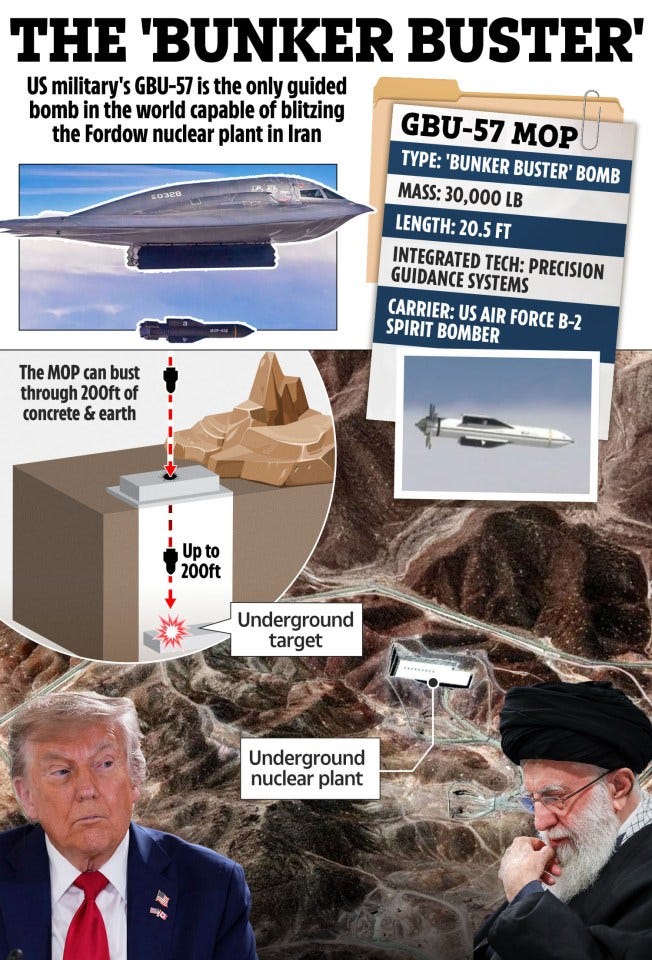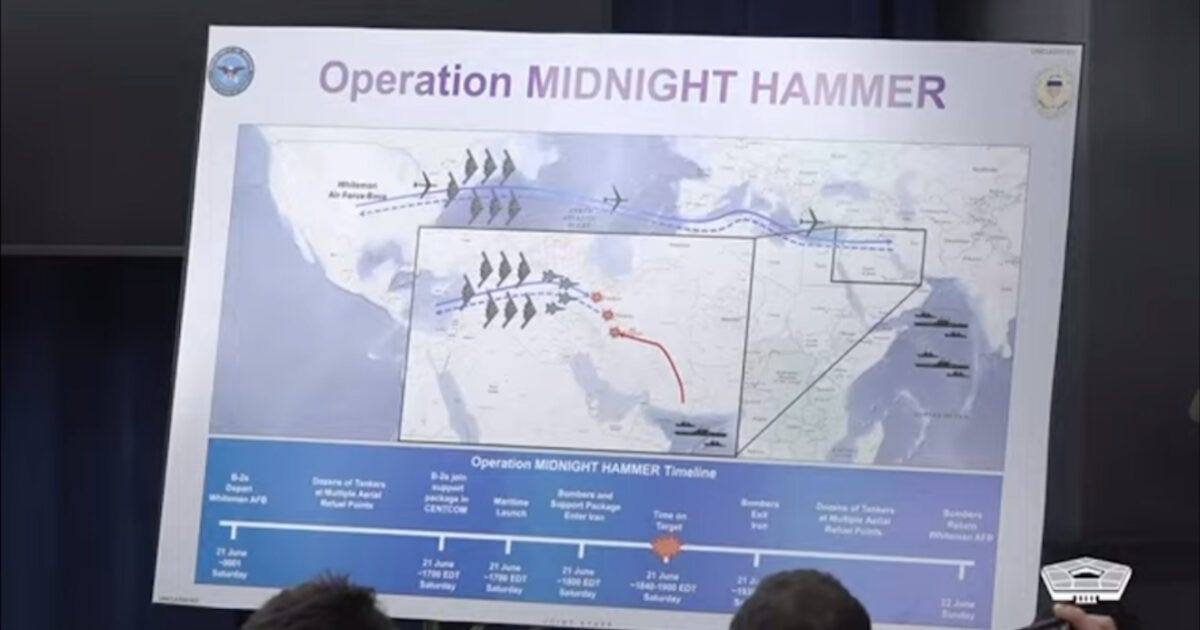“Operation MIDNIGHT HAMMER” – Defense Secretary Hegseth and General Caine Detail Highly Classified and Sophisticated Iran Operation
President Trump Sent Multiple Decoy Bombers Over the Pacific Ocean to Trick the Iranians and to Maintain Element of Surprise in Longest B-2 Spirit Bomber Mission Since 2001.
June 23, 2025
Defense Secretary Pete Hegseth and Joint Chiefs Chairman Dan Caine held a press conference this morning following the Saturday U.S. strikes on Iran nuclear facilities.
The Secretary and Chairman laid out how the classified mission was executed while retaining the element of surprise, with “very few people in Washington knowing the timing or nature of this plan” and B-2 Stealth Bomber pilots having “minimal communications” as they made their 18-hour journey into Iran.
This included decoy planes flying West into the Pacific Ocean to throw off the Iranians and the public, seven B-2s carrying Massive Ordnance Penetrator ‘Bunker Busters,’ each with two crew members, “proceeded quietly to the east.”
As The Gateway Pundit reported on Saturday, as many as six B-2s were detected heading towards Guam, which the world believed was meant for last night’s attack.
Six B-2 stealth bombers from Whiteman Air Force base in Missouri seem to be heading towards a US Air Force base in Guam, according to various flight tracking data.
"As the Operation Midnight Hammer strike package entered Iranian airspace, the U.S. employed several deception tactics, including decoys as the fourth and fifth generation aircraft pushed out in front of the strike package at high altitude and high speed, sweeping in front of the package for enemy fighters and surface to air missile threats," Joint Chiefs Chairman Dan Caine explained.
At around 2:10am local time, the lead B-2 bomber dropped two GBU-57 Bunker Buster bombs on the first aim point at Fordow, Caine said.
Caine said the mission was executed in total secrecy and U.S. planes were "in and out and back without the world knowing at all."
Caine added that they are "currently unaware of any shots fired at the US strike package on the way in" and "unaware of any shots fired at the Package on the way out."
"Initial battle damage assessments indicate that all three sites sustained extremely severe damage and destruction."
WATCH:
"Operation Midnight Hammer" included seven B-2 bombers with two crew members each, Chairman of the Joint Chiefs of Staff U.S. Air Force General Dan Caine said during a press conference Sunday morning, outlining the strikes against three of Iran's nuclear sites.
Each B-2 completed 18-hour flights with multiple in-air refuelings, according to Caine, who called it a "deliberate and precise strike" as well as a "highly classified mission."
Defense Secretary Pete Hegseth called the operation "bold and brilliant," saying that it illustrated President Donald Trump's "commitment to peace through strength."
Hegseth insisted that the operation was strictly focused on nuclear sites and was not targeting civilians.
The press conference came after President Trump announced Saturday night that the United States had carried out a "very successful" attack on three key Iranian nuclear sites: Fordow, Natanz, and Isfahan.
Why It Matters
The U.S. strikes on Iran mark a new level of American involvement following weeks of escalating conflict between Israel and Iran.
Israel initially struck Tehran and several other cities in "Operation Rising Lion," a campaign it said was meant to preempt a planned Iranian attack and disrupt Iran's nuclear capabilities.
Iran, which has said its nuclear program is for peaceful purposes, has since retaliated, though Israeli defense systems—bolstered by U.S. military technology—have intercepted about 99 percent of incoming missile fire, according to Israeli officials on Saturday morning in an X, formerly Twitter, post.
Iran hit a hospital in southern Israel on Thursday, and local reports noted that buildings in Tel Aviv were on fire from Iranian missiles on Friday.
The U.S. is Israel's closest ally, providing billions of dollars in military aid annually.
Meanwhile, many politicians on both sides have criticized President Trump's decision to strike Iran without congressional approval.
What To Know
"Operation Midnight Hammer" saw the first deployment of the massive ordinance penetrator (MOP), Hegseth told reporters on Sunday morning.
It also saw the second longest flight in U.S. military history.
He explained that the operation required "precision" and "misdirection," saying the bombers were "in and out and back without the world knowing at all."
The operation started with a distraction, having multiple aircrafts fly from Missouri over the Pacific as a ruse while the other B-2's were en route to Iran.
The strikes began at 6:40 p.m. ET Saturday, 2:10 a.m. Iran time, Caine said.
Caine said the first target, Fordow, was hit with 2 GBU-57 MOP weapons, while another 14 of those weapons were dropped on the other two nuclear target areas.
"All three Iranian nuclear infrastructure targets were struck between 6:40 p.m. and 7:05 p.m. Eastern Time again, that's about 2:10 in the morning local time in Iran, with the Tomahawk missiles being the last to strike Isfahan to ensure we retain the element of surprise throughout the operation," he said.
Around 20 GBU-57 were created by the U.S., The Wall Street Journal reported, meaning there should be four left following the operation.
Those weapons, referred to as "bunker buster" bombs were created to hit underground targets.
"U.S. forces employed approximately 75 precision guided weapons during this operation," Caine said who explained that a U.S. submarine launched more than two dozen land attack cruise missiles on Natanz and Isfahan.
Tomahawk missiles were last to strike at Isfahan.
Caine said he was "unaware of any shots fired at the U.S. strike package on the way in."
What People Are Saying
Defense Secretary Pete Hegseth said during Sunday morning's press conference:
"The operation President Trump planned was bold and it was brilliant, showing the world that American deterrence is back when this president speaks, the world should listen and the U.S. military, we can back it up. The most powerful military the world has ever known. No other country on planet Earth could have conducted the operation that the chairman is going to outline this morning."
Chairman of the Joint Chiefs of Staff Air Force General Dan Caine said during the Sunday morning press conference:
"Our forces remain on high alert and are fully postured to respond to any Iranian retaliation or proxy attacks, which would be an incredibly poor choice. We will defend ourselves. The safety of our service members and civilians remains our highest priority. This mission demonstrates the unmatched coordination and capability of the United States military in just a matter of weeks this went from strategic planning to global execution."
What Happens Next?
While officials believe the sites suffered massive damage, they are still working to determine the extent, while reaction continues to pour out from international leaders as well as U.S. politicians.
Iran's Supreme Leader Ayatollah Ali Khamenei must decide on whether or not to retaliate for the U.S. strikes and whether to continue with negotiations in some form.
READ MORE:
US 'obliterates' Iranian main nuclear sites, Tehran declares 'war starts now'
Iran, Middle East moves by President Trump have a hidden and brilliant strategy
Share or comment on this article.
Your support is crucial in exposing fake news and in helping us defeat mass censorship.








